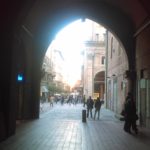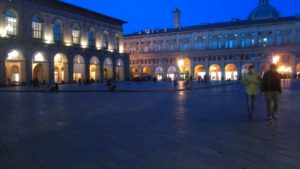
Adventure Italia: Day 2 of 9
After sleeping through the late morning we were served a large breakfast/brunch that started with buttered toast on whole-wheat bread, black olive jam, slices of cheese (cut from what looked like a two-pound block of parmigiana), and Italian flatbread (piadina). The butter went well on both breads; the jam too tasted great on the breads as well as simply smeared on slices of parmigiana. Sometimes we glazed our morsels with a thicker form of balsamic vinegar–a cream–that, upon contact with our food, congealed like liquid fudge drizzled on ice cream. The main course was spaghetti from Tosco’s mother’s homemade sauce.
We drank lots of espresso and were also offered sparkling water, fruit juice, milk. After the meal, we were given a glass of Cosimo’s grandmother’s homemade cherry wine. We also had some sips of amarezza (bitters, liqueurs) “to settle the coffee.â€
After our stomachs had relaxed, Cosimo and Chiara guided Scott and me on a walking tour through the 900-year-old city of Bologna. One of the first things we saw was the Porta Galliera (city gate) where in medieval times folks would pass through to enter this once-walled city. Nearby were a group of book stalls and stacks under a large white tent. We browsed these wares for a while. I found some specimens from the mid-1800s that were a good price but nothing in English. Scott found some old comic books and bought them.
We strolled through Bologna southward down Via dell’Indipendenza (Independence Avenue) until we came to Finestra sui Canali which reveal the ruins of Bologna’s canal system. Between the 1200s and the 1600s these canals, fed by the River Po, were used for travel and commerce from Bologna to Venice.
Next we came upon some of Bologna’s most famous and recognizable landmarks, the Due Torri (Two Towers), and while plenty of visitors shuffled about the bases of these towers, the scene was nothing like the infestation of tourists one finds at the one in Pisa. Bologna’s towers were built in the 1100s, and, like Pisa, they lean.
We continued south for a few blocks until encountering Palazzo Re Enzo, built in 1244. Some of the acoustics beneath the covered archways and porticos of this palace made for whispering galleries. Here under the arches, before the days of texting, Renaissance lads and lasses used to flirt and court each other by whispering back and forth.
(whispering gallery at Palazzo Re Enzo)
On the east side of the Palazzo stands the Neptune fountain, a special place for Cosimo and Chiara because ’tis the spot in Bologna where they, our hosts, first met. Immediately to the south of the fountain spans the Piazza Maggiore, overlooked by the Basilica of San Petronio.
Our breakfast had been large, but by evening Scott and I needed a snack. So at a mini “food mall”––possibly a place called Eataly on Via Drapperie; right off Piazza Maggiore––Scott and I split a tuna steak sandwich over some pinot grigio.
(Piazza Maggiore at night)
We walked back to our host’s apartment, then, got in their car and drove around before finding the “right†gelato place. We must’ve driven for over an hour, because lots of places close early on Mondays. Soon enough Scott and I found ourselves in a version of Goldilocks and the Three Bears: Cosimo and Chiara couldn’t decide where we should eat gelato: one saying, “No that place’s stuff is too soft, let’s go to so-in-so’sâ€; the other replying: “No, theirs is too hard––somewhere else.†Yet, like the porridge in the children’s tale, the gelato we ended up eating was “just rightâ€â€“–each of us trying three or four different flavors scooped, piled, and slathered atop petite cones. Specifically, I remember there being a lot of pistachio and strawberry cheesecake.


